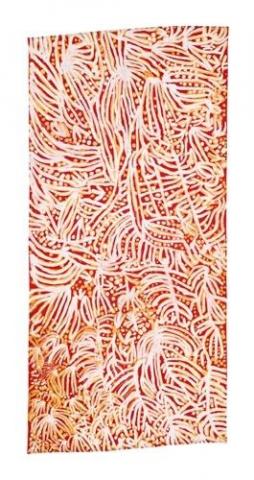URAPUNTJA , 1987
Emily Kame Kngwarreye
batik on silk
180.0 x 85.0 cm
Acquired from the CAAMA shop, Alice Springs, November 1987
Sotheby's, Sydney, 9 November 1998, lot 160
Applied Chemicals Collection, Melbourne
Of My Country: Emily Kame Kngwarreye, The Applied Chemicals Collection, Bendigo Art Gallery, 1 - 30 May 1999, and touring various venues throughout Victoria and New South Wales, June 1999 - April 2000 (illus. exhibition catalogue)
Emily Kame Kngwarreye was one of the great Australian painters of the last century whose much sought-after work is represented in every major Australian collection and who became one of the most famous Indigenous artists of her time. Yet her artistic journey differs markedly from that of any other artist. First, her prodigious output, estimated at over 4000 works - a whole lifetime's work for most other artists - started at the age of 80 and was compressed into a short eight-year span. Secondly, while her imagery progressed through a number of noticeably differing stylistic changes, it was based on a single theme - her country. 'Whole lot', Kngwarreye would say of her own art, '...that's whole lot, Awelye (My Dreaming), Arlatyeye (pencil yam), Arkerrthe (mountain devil lizard), Ntange (grass seed), Tingu (a Dreamtime pup), Ankerre (emu), Intekwe (a small plant, a favourite food of emus), Atnwerle (green bean) and Kame (yam seed). That's what I paint, whole lot.'1
Extraordinary also is that these works, whose lyrical colourism or stark monochromatic abstraction have been likened to those of artistic greats as diverse as Claude Monet, Lloyd Rees, Willem de Kooning and Jackson Pollock, were created by a woman with no knowledge of any Western art movement and almost entirely in outback desert conditions Westerners would largely regard as primitive in the extreme. Yet to view Kngwarreye as an unpracticed genius, spontaneously pouring forth masterpieces in the last years of her life is misleading. The works were rather, the culmination of a lifetime's experience of her land - learning its Dreaming stories, participating in ceremonial ground and body painting, and exercising her obligations towards the land, its bush foods and wildlife.
Born around 1910 at Alhalkere (Soakage Boar) on the northwest boundary of the former pastoral station of Utopia, 230 kilometres northeast of Alice Springs, Kngwarreye spent much of her adult life as a stock-hand on properties in the area - an exceptional role for a woman and one which offered her great independence and depth of knowledge of her land. In her later years, when she turned her attention to painting, Kngwarreye would retreat to the large bloodwood eucalypts just near the community's central hub, the Arlparra Store - sitting on the red sandy earth under a bough shelter, dipping her brush into kerosene tin paint pots and almost always accompanied by a group of relatives and friends. Another regular painting site was the veranda of the pastoralists Donald and Janet Holt, whose property Delmore Downs, abuts Kngwarreye's traditional lands and who became her major dealers. Indeed, all fifteen works on offer here were commissioned by the Delmore Gallery, and we are grateful to Janet Holt in particular for allowing us to publish several of her essays illuminating the symbolism and significance of Kngwarreye's art.
The collection of works included here encapsulates well the unique nature of Kngwarreye's artistic journey and legacy. With at least one major painting for each of the years during which she painted on canvas (1989-1996) as well as an earlier batik-dyed textile, the selection documents the evolution of Kngwarreye's style, from finely dotted pointillist canvases of intricate composition, to her 'mid-career' looser, more luminous large-dot paintings, and finally, her dynamic line paintings. For example, the earliest, the Urapuntja Batik, 1987, (lot 26), features lines tracing the flora of the area, while Bush Tomato, 1990, (lot 28), with its all-over dotting and layering of colour, signals the freedom the new acrylic medium offered Kngwarreye. Here the colouration which was to produce some of her most lyrical work predominates - an element developed to its full potential in the luminously vibrant Ceremony, 1994, (lot 35). As well as colour, the unifying theme of subsurface lines of plant roots and water paths - depicted also in Utopia women's ceremonial body painting - is seen throughout her oeuvre in works as diverse as Yam Story, 1989, (lot 27) and the two works each entitled Yam Country 95, 1995, (lots 38 & 39) while, in stark contrast to any of her previous work, the final painting Kame Colour 1996 (lot 40), executed the year of her death, bears a sense of unrestrained energy and urgency. Common to all, however, is an optical richness derived from Kngwarreye's layering technique, allowing the colours to interact, merge or bounce off one another with shimmering results.
1. The artist quoted in Neale, M., Emily Kame Kngwarreye - Alhalkere - Paintings from Utopia, Queensland Art Gallery, Brisbane and Macmillan, Melbourne, 1998.
